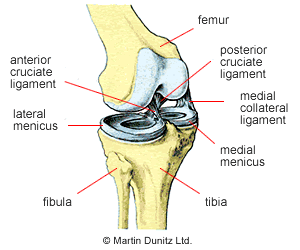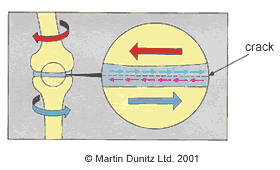| Common Signs & Symptoms | |||||
| Pain | Swelling | Stiffness | Weakness | Instability | Locking |
Torn Cartilage Explained
A torn cartilage is a common knee injury in sports. The term cartilage tear is slightly misleading, since it is the Meniscus within the knee that is actually damaged.

There are two Menisci within each knee joint that are made from tough fibrocartilage – hence the use of the term cartilage for this injury. The Menisci are roughly semicircular in shape and are markedly thicker around the rim. They are located on the Tibial plateau (the top surface of the shin bone) between the shin bone and the thigh bone. The function of the Menisci is to increase the congruence and stability of the knee joint and to act as shock absorbers during weight-bearing activity.

As the knee joint bends the thigh bone usually rolls, spins and glides on the top surface of the shin bone. However, if there is rotation caused by a twist whilst the joint is bearing weight, the Menisci can get jammed and nipped in between the two bones. If the force is sufficient, a tear of the Meniscus will occur. Sometimes a torn section of meniscus can cause a flap and also get nipped when the joint moves.
Torn Cartilage Signs & Symptoms
The Meniscus itself does not have a nerve supply, so no pain emanates from this structure. However, due to the force of the twist there is often associated damage to other knee structures. The most common structures to be damaged are the Medial Collateral Ligament (MCL) and the Coronary ligaments, which help attach the Menisci to the top of the shin bone. The damage to the joint may cause the knee joint to swell up.
In addition to the lack of nerve supply, the Menisci also have a poor blood supply, which means that, depending on the section of meniscus that is torn, the tear is unlikely to heal. As a consequence the tear produces a flap that interferes with normal joint mechanics. This produces a characteristic ‘clunk’ within the knee when it is bent and straightened and it may cause the joint to lock in one position. Frequently the knee gives way, particularly when walking downstairs.
Torn Cartilage Treatment
What you can do
| Consult a sports injury expert | |
| Apply ice packs/cold therapy | |
| Wear a knee brace for protection | |
| Use a buoyancy aid for pool exercises | |
| Use a Wobble Board during rehab to improve proprioception |
In some cases, after the initial knee pain and swelling, the knee joint settles down and normal activities can be resumed. This is because the tear in the Meniscus is small or the flap does not affect the joint mechanics. However, in the case of a sporting individual, the flap can cause the knee to sporadically lock or give way, then surgery is required. This is carried out arthroscopically, whereby a small camera and burring device are used by the knee surgeon to remove the flap and smooth off the surface of the Meniscus. The patient is usually in hospital for one night and can then begin rehabilitation.
The initial goals of physiotherapy treatment are to reduce knee pain and knee swelling. Ice Packs can be applied for periods of twenty minutes every couple of hours (never apply ice directly to the skin as it can cause an ice burn) to relieve pain and reduce bleeding within the tissue. The Aircast Knee Cryo/Cuff is the most effective method of providing ice therapy and can be used for the home treatment of knee injuries and knee pain. It can provide continuous ice cold water and compression for 6 hours to significantly reduce knee pain and knee swelling.
A Knee Brace can restore a degree of knee joint stability, whilst you rebuild the strength around the joint, preventing the feeling that the knee is going to ‘give way’. Together with physiotherapy treatment, a Knee Brace can help to restore knee joint confidence. Modern Knee Braces provide stability without compromising knee movement, so can be used during rehabilitation and on return to sporting activities.
Once the surgical wounds have fully healed then hydrotherapy (exercise in water) is an ideal method of maintaining fitness. A Buoyancy Aid can be worn and allows the user to jog in water without touching the bottom of the pool. This helps to restore knee range of movement, as well as providing excellent cardiovascular training and functional rehabilitation of the entire lower limb. It is ideal following cartilage surgery as pool running puts no weight bearing stress on the knee joint and the hydrostatic pressure of the water can help further reduce swelling around the area.
Torn Cartilage Prevention
Unfortunately, a torn cartilage is very difficult to prevent. Maintaining Quadriceps and Hamstring muscle strength, to protect the knee joint, is probably the most effective prevention strategy. As the knee lies anatomically between the ankle and the hip, working on improving balance and ankle strength, such as with a wobble board, as well as glute exercises can help strengthen the whole chain and lessen the load on the knee.


